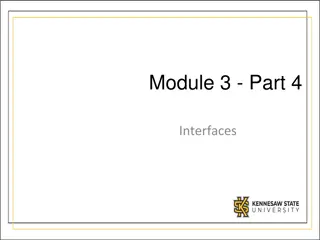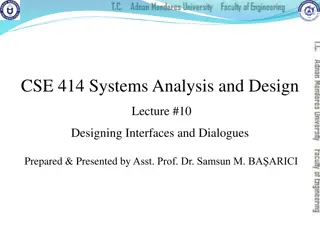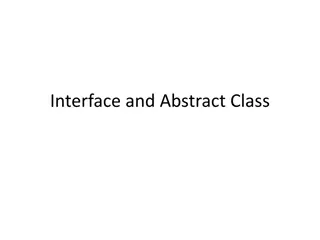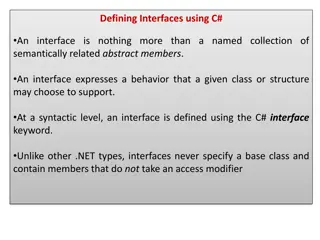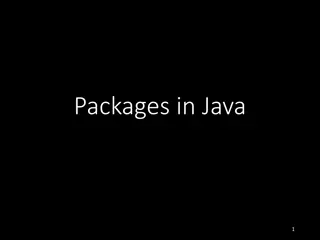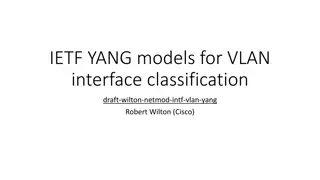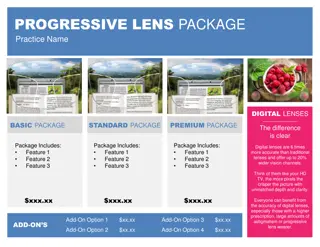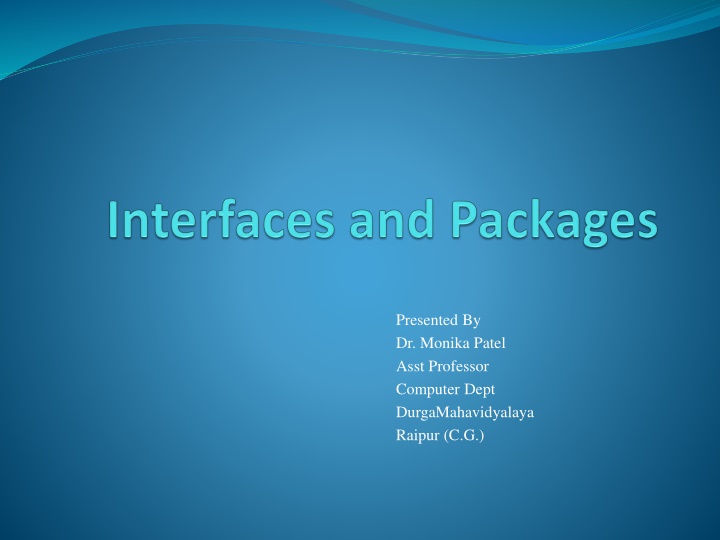
Interfaces in Object-Oriented Programming
Learn about interfaces in object-oriented programming and how they define a protocol of behavior, set of methods, and reserved behaviors for classes. Explore the differences between interfaces and abstract classes, as well as how to define an interface in Java.
Download Presentation

Please find below an Image/Link to download the presentation.
The content on the website is provided AS IS for your information and personal use only. It may not be sold, licensed, or shared on other websites without obtaining consent from the author. If you encounter any issues during the download, it is possible that the publisher has removed the file from their server.
You are allowed to download the files provided on this website for personal or commercial use, subject to the condition that they are used lawfully. All files are the property of their respective owners.
The content on the website is provided AS IS for your information and personal use only. It may not be sold, licensed, or shared on other websites without obtaining consent from the author.
E N D
Presentation Transcript
Presented By Dr. Monika Patel Asst Professor Computer Dept DurgaMahavidyalaya Raipur (C.G.)
What is an Interface? An interface defines a protocol of behavior that can be implemented by any class anywhere in the class hierarchy. An interface defines a set of methods but does not implement them. A class that implements the interface agrees to implement all the methods defined in the interface, thereby agreeing to certain behavior. An interface is a named collection of method definitions (without implementations). Interface reserve behaviors for classes that implement them. 2
Methods declared in an interface are always public and abstract, therefore Java compiler will not complain if you omit both keywords Static methods cannot be declared in the interfaces these methods are never abstract and do not express behavior of objects Variables can be declared in the interfaces. They can only be declared as static and final. Both keyword are assumed by default and can be safely omitted. Sometimes interfaces declare only constants be used to effectively import sets of related constants. 3
Interface vs. Abstract Class An interface is simply a list of unimplemented, and therefore abstract, methods. An interface cannot implement any methods, whereas an abstract class can. A class can implement many interfaces but can have only one superclass. An interface is not part of the class hierarchy. Unrelated classes can implement the same interface. 4
Defining an Interface Defining an interface is similar to creating a new class. An interface definition has two components: the interface declaration and the interface body. interfaceDeclaration { interfaceBody } The interfaceDeclaration declares various attributes about the interface such as its name and whether it extends another interface. The interfaceBody contains the constant and method declarations within the interface 5
public interface StockWatcher { final String sunTicker = "SUNW"; final String oracleTicker = "ORCL"; final String ciscoTicker = "CSCO"; void valueChanged (String tickerSymbol, double newValue); } If you do not specify that your interface is public, your interface will be accessible only to classes that are defined in the same package as the interface 6
Implementing an Interface Include an implements clause in the class declaration. A class can implement more than one interface (the Java platform inheritance for interfaces), so the implements keyword is followed by a comma-separated list of the interfaces implemented by the class. When implement an interface, either the class must implement all the methods declared in the interface and its superinterfaces, or the class must be declared abstract supports multiple 7
class C { public static final int A = 1; } interface I { public int A = 2; } class X implements I { public static void main (String[] args) { int I = C.A, j = A; } } 8
public class StockMonitor implements StockWatcher { ... public void valueChanged (String tickerSymbol, double newValue) { if (tickerSymbol.equals(sunTicker)) { ... } else if (tickerSymbol.equals(oracleTicker)) { ... } else if (tickerSymbol.equals(ciscoTicker)) { ... } } } 9
Properties of Interface A new interface is a new reference data type. Interfaces are not instantiated with new, but they have certain properties similar to ordinary classes You can declare that an object variable will be of that interface type e.g. Comparable x = new Tile( ); Tile y = new Tile( ); if (x.compareTo(y) < 0) 10
What is Package? A package is a collection of related classes and interfaces providing access protection and namespace management. To make classes easier to find and to use To avoid naming conflicts To control access 11
Why Using Packages? Programmers can easily determine that these classes and interfaces are related. Programmers know where to find classes and interfaces that provide functions. The names of classes won t conflict with class names in other packages, because the package creates a new namespace. Allow classes within the package to have unrestricted access to one another yet still restrict access for classes outside the package graphics-related 12
Put Your Classes and Interfaces into Packages It is no need to create packages, they come to existence as soon as they are declared The first line of your source file: package <package_name>; e.g. package cars; class Car { } Every class must belong to one package. Only one package statement is allowed per source file. If package statement is omitted, the class belongs to a special default package the only package in Java that has no name. 13
Subpackages We can create hierarchies of nested packages e.g. package machines.vehicles.cars; class FastCar extends Car { } Subpackage names must always be prefixed with names of all enclosing packages. Package hierarchy does not have a single top- level all-encompassing root package.Instead, we deal with a collection of top-level packages 14
Partial Package Tree of Java java lang String Math reflect Constructor Method awt Frame Button io ObjectInputStream ObjectOutputStream util Vector Random 15
Packages and Class Packages subdivide name space of Java classes machines.vehicles.cars.FastCar mycar = new machine.vehicles.cars.FastCar(); Package names should be made as unique as possible to prevent name clashes Class name must be fully qualified with their package name. Except: Class name immediately following the class keyword, e.g. class Car{ } Class belongs to the same package as the class being currently defined Class is explicitly specified in one of the import statements Class belongs to java.lang package (all java.lang classes are implicitly imported) 16
import Statement To avoid typing fully qualified names use import statements sandwiched between the package statement and class definition. e.g. package grand.prix; import java.lang.*; //implicitly specified import java.util.Random; import machines.vehicles.cars.*; import machines.*.*; //COMPILER ERROR! import Racer; //from default package class SuperFastCar extends FastCar { private Racer r; public static void main(String{[] args) { Random RNG = new Random(); java.util.Vector v = } } new java.util.Vector(); 17







